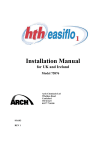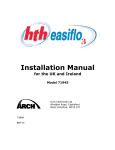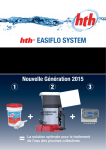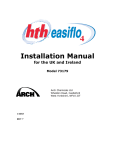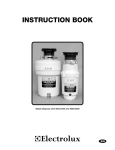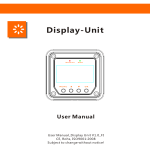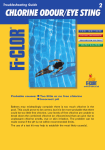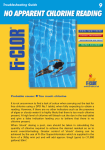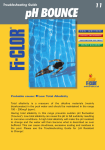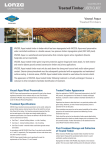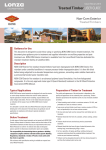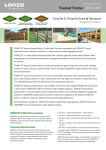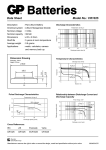Download Installation Manual
Transcript
Installation Manual for UK and Ireland Model 76826 Issued 05/2014 Arch Chemicals Ltd, a Lonza company. Wheldon Road, Castleford, West Yorkshire, WF10 2JT Tel: 01977 714100 Fax: 0870 889 5277 Email: [email protected] www.lonza.com www.hth.co.uk ® hth and Easiflo are registered trademarks of Arch Chemicals Ltd www.hth.co.uk Installation Manual for UK and Ireland General Principles of Installation The Easiflo® 1 feeder is an atmospheric system designed for pools ranging from 50 to 300 m3 depending on bather load and operating conditions. It is possible to install the feeder on a pool and also dose a spa or small pool with a conventional dosing pump, drawing solution from the discharge tank, but this possibility again depends on volumes and bather load. There are different types of installation: 1. As detailed in this manual, above grade or below grade installation which depends on the location of the pool pump. Both installations use the small feeder venturi to inject chlorine post filter/heater. 2. Installation using the venturi and booster pump to evacuate the chlorine solution produced by the feeder into the circulation line of the pool, as shown in Schematic 2BP. 3. Installation using a venturi which employs the motive power of the pools’ own circulating pump. In this instance consultation with technical services is necessary to advise on feasibility. Lonza Technical Services personnel can help with all these matters, tel. 01977 714100 for advice if needed. Selecting a location for the Easiflo® 1 Choose a location in the pump room that will allow easy access and service. Always try to minimize the length of the outlet tubing when locating the Easiflo® 1. The Easiflo® 1 comes with 6 metres of half inch OD polyethylene tubing. 2 Installation Manual for UK and Ireland Equipment Required for Feeder Installation Drill - Cordless Recommended PVC Primer/Cleaner and PVC Glue Tube Cutters or Utility Knife Saw to cut PVC Pipe /2” BSP Tap and 11/16” Drill Bit Gas Pliers (Channel Locks) /2” (M)BSP x 1/4” (F)BSP Reducing Bushing Vacuum Gauge (Inches of Hg) 1 1 PTFE or Pipe Sealant Equipment Required for Venturi Installation 1” PVC Pipe and Fittings (elbows, tees etc.) 11/2” BSP Tap and 13/4” Hole Saw (Optional) Ball or Gate Valve for Pool Return Line Saddle Clamps (optional) Parts Included with the Easiflo® 1 Feeder (see pages 11-13 for corresponding part numbers) 1 23 (3) Parker tubing connector: /2” OD tube x 1 /2” (F)BSP (P8FC8) for discharge valve and flow indicator 1 25 /2” OD Polyethylene Tubing (6 metres) /2” (F)BSP threaded Sch. 40 PVC coupling for Venturi 1 27 Arch Venturi (2) 1/2” PVC Nipples 21 (2) 1/2” (F)BSP x (F)BSP PVC ball valve/ W8MC8 1 28 (2) 1 /2” Slip x Slip Sch. 40 PVC Unions, Venturi fittings 24 0 - 4lts Acrylic Flow Indicator 22 Parker tubing connector: 1/2” Tube x 1/2” (M) BSP (P8MC4) for ESV inlet Will the Small Feeder Venturi Work at the Site? Install the venturi loop as shown in the appropriate Installation Schematic for either an above or below grade filtration system. The primary difference between the two is the use of ball valves on the below grade installation to allow the loop to be isolated from the pool system for service. Once the loop has been installed using the step by step instructions in the Installation Manual, adjust the pressure differential ball valve to achieve a vacuum reading of 13” Hg. Backwash or clean the filter and measure the effluent pressure of the pool system after the heater at “P1” in the Installation Schematic. If this pressure is 17psi or less and the minimum flow rate of the pool is greater than 170 lts /min, the small feeder venturi will provide adequate suction to operate the Easiflo® 1. The chart overleaf lists the suction flow generated by the small feeder venturi at various pressure differentials. 3 Installation Manual for UK and Ireland Easiflo® 1 Venturi Installation: Theory (excluding Booster Pump) Flow to the venturi is taken from the pressure side of the pool recirculation pump after the filter and heater loop (if present). Flow from the venturi is returned downstream of the venturi inlet. A partially closed valve in between the venturi inlet and outlet provides the pressure drop needed to power the venturi. The three critical parameters in choosing a venturi are the inlet and outlet pressures and the suction lift. The Venturi must be capable of evacuating 4lt /min from the discharge tank when the filter is dirty. Suction flow will decrease with an increase in filter pressure as less water will flow through venturi. Always minimize the backpressure when installing a venturi. This includes eliminating/minimizing any elbows on the outlet side of the venturi. In addition, if the venturi is located more than 0.9 metres above the feeder outlet, it will be necessary to calculate the effect of the suction lift loss on outlet flow. Follow instructions below to perform the Suction Lift calculation if required. Inlet Pressure Outlet Pressure Flow Through Suction Flow (psi) (psi) Venturi (lts /min) ‘F1’ (lts /min) 5.5 5 87 3.78 6 5 106 6.00 6.5 6 91 3.78 7.5 6 106 1.5 7.5 7 98 3.78 8 7 106 4.92 12 10 121 3.78 12.5 10 128 4.92 15.5 12 140 3.78 17.5 15 144 3.78 18 15 148 4.92 21.5 17 155 3.78 22 17 159 4.92 After the evacuation system has been laid out, measure the height differential (in metres) between the venturi and discharge valve of the Easiflo®1 feeder. Use this height differential to calculate the suction lift factor in the formula that follows. Suction lift factor = (10.37 – height differential in metres) / 10.37 Example: height differential is 2 metres, therefore Suction lift factor = (10.37 - 2) / 10.37 = 8.37 / 10.37 = 0.81 Take the suction flow (F1) and multiply it by the suction lift factor to get the actual outlet flow. The formula is: F1 x suction lift factor = actual outlet flow The maximum recommended elapsed time to drain a 2 litre bottle of water (positioned at the same height of the Easiflo®1 discharge valve) is 30 seconds. This corresponds to an outlet flow-rate of approximately 4 litres per minute. After installation, it is important to check the evacuation cycle of the Easiflo®1 Feeder to ensure that the drain time of the discharge tank is adequate. 4 Installation Manual for UK and Ireland Schematic 2AG - Above Grade 5 Installation Manual for UK and Ireland Schematic 2BG - Below Grade 6 Installation Manual for UK and Ireland Schematic 2BP - Booster Pump 7 Installation Manual for UK and Ireland Easiflo® 1 Venturi Installation Refer to Schematic 2AG for above grade pool system installation or Schematic 2BG for a below grade pool system installation and follow the steps below. 1 Drill a 13/4” hole (Fig 1) at location “VS1” found on the schematic drawing. Tap the 13/4” hole with a 11/2” BSP tap (Fig 2). Options for this step include the use of saddle clamps instead of drilling and tapping or splice in a tee with 1” pipe size (Fig 3) leading to Venturi System loop. 2 Install a Ball or Gate valve at location “PD1” in Schematic (Fig 4). Background The next steps involve creating a bypass loop on the pool return line for installation of a Venturi. This loop can be created by drilling and tapping or splicing into the return line with Tee’s. We refer to using the drill and tap method. You may find it preferable to splice in Tee’s to make these connections. It will also be necessary to install a ball (or gate) valve in the return line at location “PD1” in the schematic drawing. This valve when partially closed, will force water to flow through the venturi creating the suction needed to evacuate the feeder. 3 Drill a 13/4” hole (Fig 1) at “VS2” on Schematic. Tap the 13/4” hole with a 11/2” BSP tap (Fig 2). Options for this step include the use of saddle clamps instead of drilling and tapping or splice in a tee with 11/2” pipe size (Fig 3) leading to Venturi System loop. Note: Below grade systems will require the Fig 1 addition of ball valves at locations “BV1 & BV2” in schematic #2BG. This will allow the Venturi System to be isolated for servicing. Fig 2 4 Take one Union for the Venturi system apart. Note that they have different halves. Glue these two halves of the union onto the Venturi (Fig 5). 5 Take the other union apart and install on the union halves on the Venturi. (Fig 6). Fig 3 Fig 4 Fig 5 Fig 6 6 Apply PTFE tape to both ends of 1/2” ball valve and install Parker tubing connector (W8FC8) on one end of the 1/2” ball valve. 8 Installation Manual for UK and Ireland 7 Install 1/2” ball valve onto venturi (Fig 7). 8 Close the valve (Fig 8). 9 Note the arrow on the venturi indicating the direction of flow (Fig 9). If there is no arrow Fig 7 marked on your Venturi, the direction of flow must go from the shorter end to the longer end. Fig 8 Fig 9 10 Complete installation of venturi bypass loop using 11/2” PVC pipe and fittings. There are four methods profiled in the following figures. Drill & Tap Note: When performing step 10, make sure the venturi is installed with correct direction of flow. Above Grade Below Grade Tees Refer to glue manufacturers recommendations regarding drying times, before re-starting the pool pump. Above Grade Below Grade 9 Installation Manual for UK and Ireland Connecting the Easiflo® 1 to the Pool Recirculation System Adjusting and Testing the Outlet Flow Rate 1 Place the Easiflo® 1 feeder in the pump room following the recommendations in the section ‘Selecting a location for the Easiflo 1’. Install vacuum gauge with 1” MBSP x 1” FBSP fitting into coupling and install on the Venturi. 2 Drill & Tap /2” BSP hole in effluent pipe @ “T1” in Installation Schematic. Start pool system and open all valves on the venturi loop. Slowly close “PD1” until the vacuum gauge reads 13” Hg. 1 3 Install nipple and W8MC8 on 1/2” ball valve and install ball valve in threaded hole. Close valve to feeder inlet. Put “Do Not Adjust” tag on “PD1”. 4 Loosen the nut on the tubing connector on the inlet to the Easiflo® 1 and push the 1/2” OD polyethylene tubing into the connector and hand tighten. 5 Flow Indicator Installation Mount the Flow Indicator (provided with the Easiflo® 1), where it is easily read. Remove vacuum gauge and install outlet ball valve with fitting. Close the outlet ball valve. Connect 1/2” tubing to fitting on outlet ball valve. Re-open feeder water inlet valve. Check outlet flow with following procedure: Splice into inlet tubing and connect inlet flow to bottom port of flow indicator. Fill a 2 litre bottle with water. Place near Easiflo®1 Discharge valve. Connect tubing from feeder inlet to top outlet port of flow indicator. 6 Run the tubing to the inlet ball valve installed in step 3 and cut to desired length. Loosen the nut on the tubing connector on the inlet ball valve and push the 1/2” OD polyethylene tubing into the connector and hand tighten. 7 Loosen the nut on the tubing connector on the discharge valve of the Easiflo® 1 and push the 1 /2” OD polyethylene tubing into the connector and hand tighten. Disconnect the tubing from the discharge valve and place end of tubing at bottom of 2 litre bottle. Open outlet ball valve and record time it takes to empty the bottle. It should take 30 seconds or less to empty the bottle.This corresponds to an outlet flow rate of 4 lt / min or greater. Close outlet ball valve and connect tubing to the discharge valve. 8 Run the tubing to the outlet ball valve on venturi and cut to desired length. Loosen the nut on the tubing connector on the outlet ball valve and push the 1/2” OD polyethylene tubing into the connector and hand tighten. The same result can be obtained by emptying 2 litres of water into the feeder base and meauring the time until the discharge valve closes. WARRANTY POLICY The Easiflo® Feeder comes with a 13 month warranty from the date of purchase from Lonza. For the warranty to be upheld, in the event of malfunction or damage other than normal wear and tear, all parts must be returned to us with notification of the feeder’s unique serial reference number to: Lonza, Arch Chemicals Ltd, Wheldon Road, Castleford WF10 2JT. 10 Installation Manual for UK and Ireland Detail and part numbers 11 Installation Manual for UK and Ireland Detail and part numbers 12 Installation Manual for UK and Ireland Detail and part numbers No. I 2 3 4 5 6 7 8 9 10 II 12 13 14 15 16 17 18 19 20 21 22 23 24 25 26 27 28 29 30 31 32 33 34 35 36 Part 74066 77334 77332 79879 77331 79806 79217 71496 71910 74059 71619 71618 71535 71538 71540 71539 71536 71537 79808 71583 71890 71614 71588 74060 71626 71621/27 71611 71974 77020 79218 77333 77336 71576 352481 79804 Description EI Base EI Hopper EI Grid EI Lid EI Dissolving Cup with Nozzles Assembly Discharge Valve Body Discharge Valve Arm Emergency Shut Off Valve Assembly - part 71910 not included Rubber Gasket for Emergency Shut Off Valve Parker Fitting W6FE4 Elbow (W6ME6) 3/8” For Feeders 30991 & P3, PI 3/ ” PE Tubing (2 ft) 8 Emergency Shut Off Valve with Arm Only Emergency Shut Off Float Plate PVC Nut/Discharge Arm Nut Emergency Shut Off Overflow Float Emergency Shut Off Float Plate Emergency Shut Off Mounting Plate Emergency Shut Off Mounting PVC Screws (1/4 x 20 x 21/4) Discharge Valve Float Discharge Valve Locknut Parker Fitting, W8MC8 Tube Connector (P8MC4) (also for solenoid) (5008) 112” x 112” Female Connector (P8FC8) Flow Indicator - EI 6 mts 112” 0.0. PE Tubing Inlet /Outlet (W8FC8) 1/ ” x close PVC Nipple Parker Tubing Connector 2 White Venturi Solenoid E1-E3 Grid Hook Non-Return Valve Hinge Pin Hinge Dishcharge Valve Gasket Dishcharge Valve Lock Nut Spanner Discharge Valve Assembly 13 Installation Manual for UK and Ireland LONZA water treatment products Emergency Response Procedure for Customers 1. In the event of a Health, Safety or Environmental Emergency involving Lonza water treatment products. This includes • Injury to persons requiring medical treatment • Loss of containment of product to the environment • Involvement of the Emergency Services (Police, Fire, Medical) • Involvement of the Environmental agencies • Major damage to property FIRST TELEPHONE +44 (0)1235 239670 This will connect you with the NCEC (National Chemical Emergency Centre) who support the Lonza Emergency Response. (It operates 24 hours a day, 365 days a year). THEN Phone your local Lonza office (during office hours) 2. NCEC will provide initial assistance and advice (in English). 3. NCEC will also contact Lonza Head Office. 4. When calling the Emergency number, have the following information available (use your Emergency Response Procedure Checklist): • Your name • Your job title • Your company name and location • The Telephone (and fax) number that you can be contacted on • The Product Name • The Product Code • The nature of the emergency • The action you have taken • Are the emergency services involved? • Are the environmental agencies involved? PLEASE ALWAYS CONTACT NCEC IN THE EVENT OF A HEALTH, SAFETY OR ENVIRONMENTAL EMERGENCY INVOLVING LONZA WATER TREATMENT PRODUCTS BUT PLEASE ONLY USE THIS NUMBER FOR HEALTH, SAFETY AND ENVIRONMENTAL EMERGENCIES (as defined above). 14














